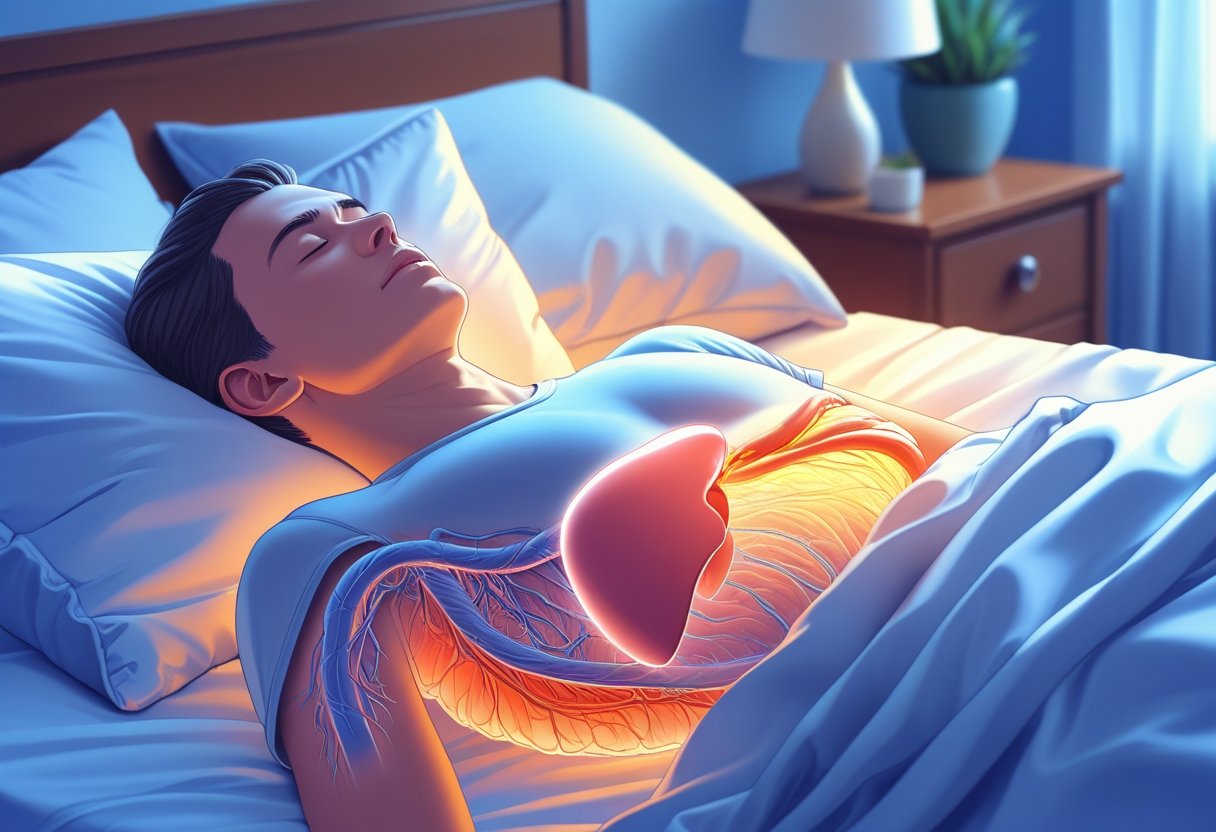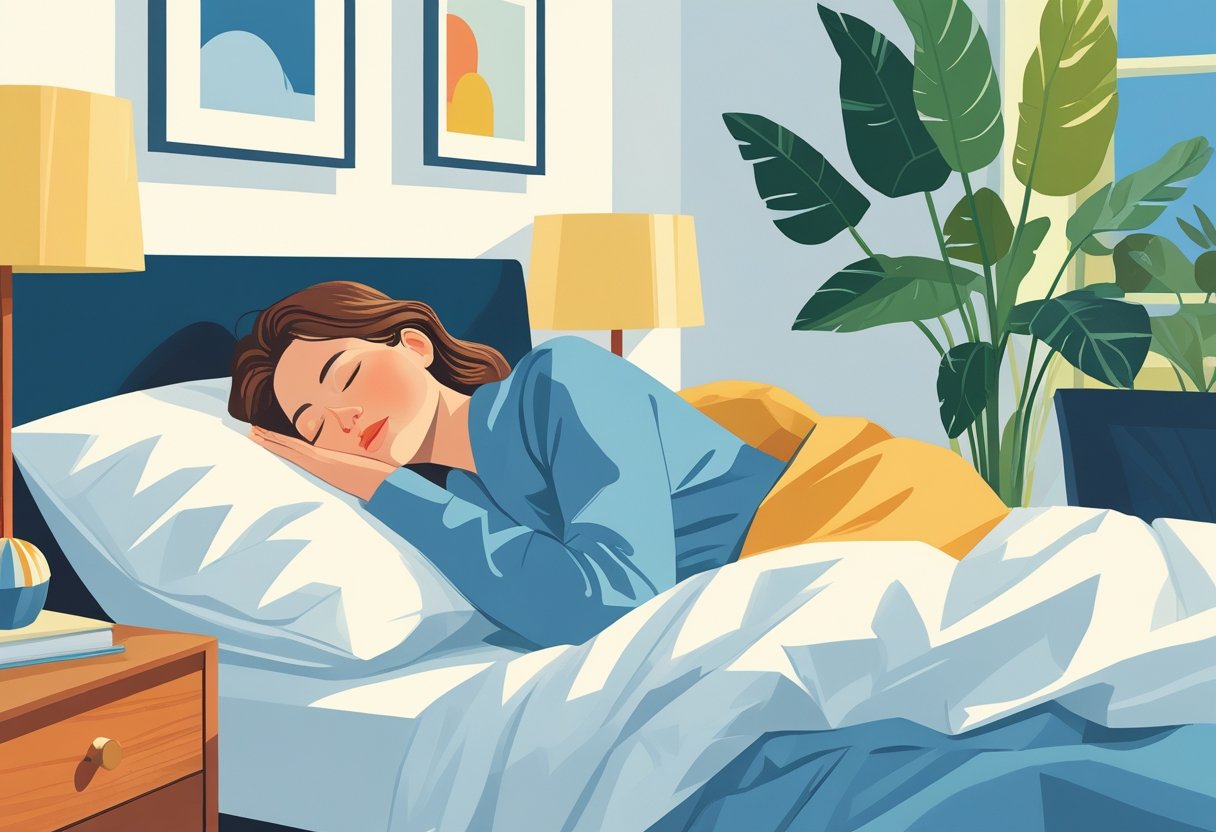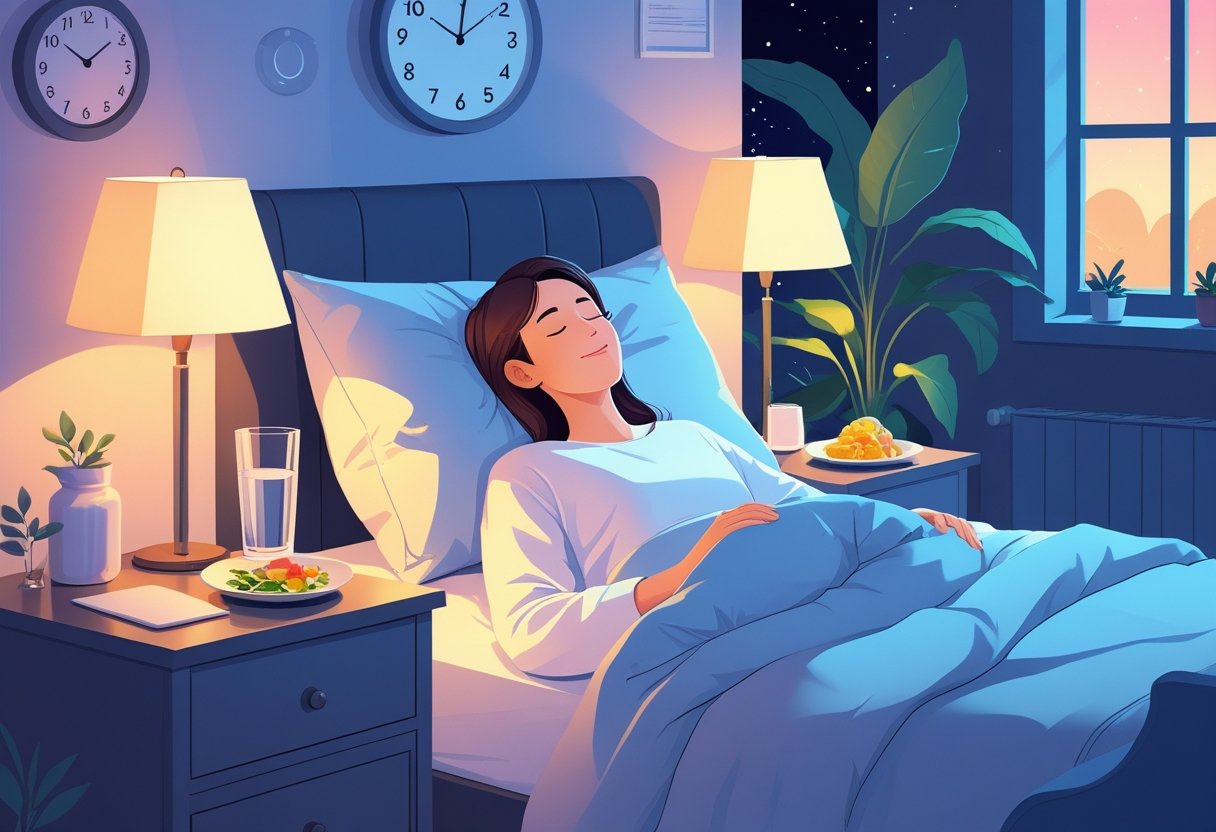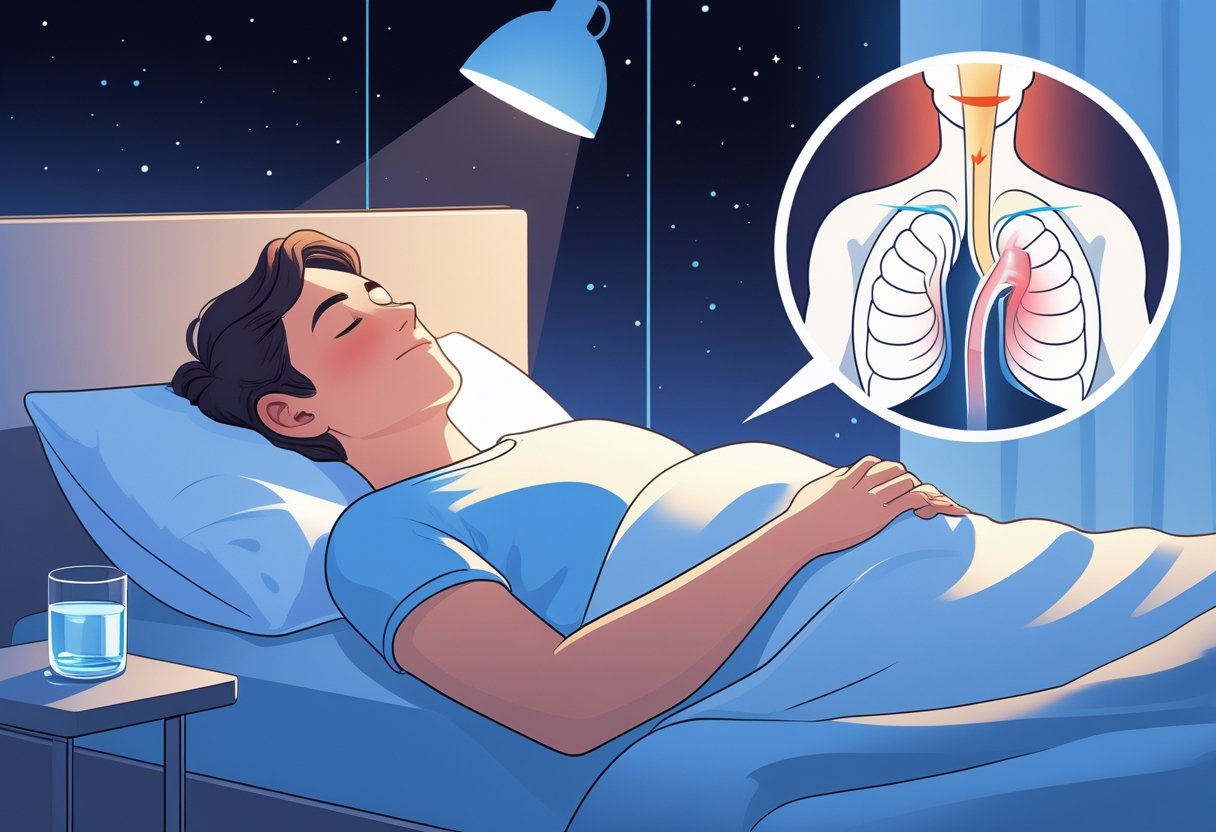For those who experience heartburn at night, the right sleep position can help. Sleeping on the left side is most effective in reducing heartburn, as it helps prevent stomach acid from flowing back into the esophagus. This small adjustment eases discomfort and improves sleep quality.
Many struggle with nighttime heartburn without realizing that the side they lie on affects acid reflux. Sleeping on the right side or back often worsens symptoms; however, lying on the left side uses gravity to keep acid down and reduce pain.
The side you choose matters, but how your body is positioned also plays a role in managing heartburn. Simple adjustments in sleep posture may bring relief without relying on medication or medical intervention.
Key Takeaways
- Sleeping on the left side reduces acid reflux at night.
- Body position influences how much acid reaches the esophagus during sleep.
- Adjusting sleep habits improves heartburn symptoms without requiring medicine.
- Sleeping on your left side with a supportive and elevated mattress setup helps reduce heart burn and improves sleep quality.


Heartburn and acid reflux occur when stomach acid moves up into the esophagus, especially while lying down. These issues often intensify during sleep, leading to discomfort and poor rest.
What Is Heartburn?
Heartburn feels like a burning sensation in the chest or throat. It starts when stomach acid irritates the lining of the esophagus, usually after eating or when lying down. Many describe it as a hot or sharp pain behind the breastbone.
Common signs include a sour or bitter taste in the mouth and discomfort that lasts for hours. Triggers may include certain foods, stress, or a weak muscle that normally keeps acid in the stomach. Lying down can make it worse since acid flows back more easily in that position.
How Acid Reflux Occurs
Acid reflux takes place when stomach acid escapes into the esophagus. Normally, the lower esophageal sphincter (LES) prevents this. If the LES weakens or relaxes too much, acid leaks out and causes irritation. Lying flat removes the help of gravity in keeping acid down, which increases reflux at night. Symptoms such as burning, chest pain, and regurgitation often appear during sleep. These episodes may wake someone or prevent restful sleep.
Factors like large meals, excess weight, or certain medications can lead to nighttime reflux. Choosing the right sleep position can reduce how much acid reaches the esophagus and improve sleep quality.
GERD and Nighttime Symptoms
Gastroesophageal reflux disease (GERD) is a chronic form of acid reflux. It involves frequent or severe reflux episodes, including nighttime symptoms. People with GERD often face reflux while sleeping, along with chest pain and coughing. Reflux becomes more damaging at night because acid remains in the esophagus longer. This leads to irritation and inflammation. Symptoms may include regurgitation, choking, or trouble swallowing.
GERD at night can greatly affect sleep. Some individuals struggle to breathe or develop a hoarse voice from prolonged acid exposure. Managing nighttime reflux usually requires lifestyle changes and adjusting sleep posture to limit acid contact.
Sleeping position directly affects how stomach acid moves through the body at rest. Certain positions keep acid in the stomach and reduce discomfort, while others allow acid to flow back into the esophagus, leading to heartburn and interrupted sleep.
Impact of Gravity and Anatomy
Gravity is essential in acid reflux during sleep. Lying flat on the back or right side lets stomach acid move more easily into the esophagus. In these positions, the lower esophageal sphincter, meant to block acid, often fails to stay closed. Sleeping on the left side takes advantage of gravity to keep acid in the stomach. On this side, the stomach sits lower than the esophagus, and the angle discourages acid from flowing upward.
Body position during sleep either protects the esophagus or leaves it exposed to acid. It affects how the sphincter functions and how quickly acid clears. For this reason, the left side is often recommended as the best sleep position for heartburn and GERD.
Common Sleep Positions and Their Effects
Left Side:
- Positions the stomach below the esophagus
- Reduces acid reflux and heartburn
- Improves acid clearance
Right Side:
- Allows the stomach to sit above the esophagus
- Increases the likelihood of reflux
- Often associated with worse symptoms
Back:
- Encourages acid to flow back due to flat alignment
- Leads to more frequent heartburn
- Not recommended for GERD
Stomach (face down):
- May reduce reflux slightly
- Can strain the neck and spine
- Hard to maintain all night
Choosing the right sleep position offers a simple and effective way to reduce reflux symptoms. When combined with lifestyle changes, it improves both comfort and sleep quality.
Risks of Poor Sleeping Posture
Sleeping in positions that worsen reflux may cause long-term damage to the esophagus. Repeated acid exposure leads to inflammation, ulcers, or Barrett’s esophagus, a more serious condition.
Poor posture also increases the frequency of nighttime heartburn, which causes disrupted sleep, fatigue, and declining health. Ignoring proper sleep positioning often leads to worsening symptoms. Body posture at night plays a key role in managing GERD, alongside diet and medication.
By avoiding flat or right-side sleeping, people lower the chance of acid reaching the throat and causing irritation. Maintaining a protective sleep position supports esophageal health and improves daily well-being.

Choosing the right sleeping side influences the severity of heartburn and acid reflux symptoms. The left side offers better symptom control due to the anatomical alignment of the stomach and esophagus. Understanding the effects of each sleeping position clarifies why certain sides provide greater relief.
Left Side vs. Right Side: What the Research Shows
Most research supports sleeping on the left side to reduce acid reflux and heartburn. This position places the stomach in a way that prevents acid from backing up into the esophagus. Several studies, including findings from health professionals, report fewer reflux events and less nighttime heartburn when lying on the left side.
In contrast, sleeping on the right side may increase acid reflux. This position allows stomach acid to move more easily into the esophagus, which can worsen symptoms. People who experience frequent acid reflux often report discomfort when sleeping on the right side.
Physiological Mechanisms Behind Side Sleeping
The relationship between stomach and esophagus anatomy plays a key role in how side sleeping affects reflux. When lying on the left side, the stomach’s natural shape keeps its contents positioned below the esophagus, allowing gravity to help reduce acid movement.
The lower esophageal sphincter (LES), a muscle that blocks acid from rising, also functions more effectively in this position. On the right side, the stomach lies above the esophagus, which increases the chances of acid escaping and causing heartburn.
Both gravity and stomach structure explain why experts generally recommend sleeping on the left side for reflux relief.
Potential Drawbacks of Right-Side or Back Sleeping
Right-side or back sleeping often worsens heartburn. The right side permits acid to travel upward more easily, which leads to more frequent reflux episodes.
Back sleeping presents its own issues by potentially relaxing the LES, which allows stomach acid to flow into the esophagus. This position may trigger more severe heartburn symptoms during the night, especially in individuals with chronic acid reflux.

Sleeping in the right way can reduce heartburn and acid reflux. Raising the upper body and choosing the right pillow or mattress helps keep stomach acid where it belongs. Adjusting the bed to keep the body slightly inclined also lowers symptoms for many people with GERD.
Alignment of the Upper Body
Keeping the upper body elevated by about 6 to 8 inches prevents stomach acid from rising into the esophagus. This reduces irritation and heartburn during sleep. The head, neck, and chest should stay higher than the stomach so gravity can keep acid down.
Sleeping flat worsens acid reflux. People with acid reflux should avoid lying flat on their backs or stomachs at night. Sleeping on the left side proves best since it keeps the stomach below the esophagus, which reduces acid backflow and improves comfort.
Pillow and Mattress Recommendations
Using a firm, supportive pillow maintains proper neck and head alignment. A higher loft pillow designed for side sleepers works best to keep the head elevated without bending the neck forward. Thin pillows provide insufficient lift and may worsen reflux.
A mattress that supports the body without sagging maintains proper spine and upper body alignment. Memory foam or adjustable mattresses suit this purpose well. Very soft mattresses fail to hold your position and can increase acid reflux symptoms.
Using Wedges or Bed Adjustments
A wedge pillow or adjustable bed incline raises the upper body evenly from head to waist, which helps keep stomach acid from moving upwards during sleep. A solid wedge pillow offers more stability than stacking pillows, which tend to slide down or cause bending at the waist.
Adjusting the bed to a slight incline between 30 to 45 degrees remains the most effective method to reduce acid reflux. Adjustable beds allow easy repositioning without discomfort. Elevating the head of the bed by 6 to 8 inches using blocks under bed legs also works well for those without an adjustable frame.

Certain habits help lower the chances of heartburn during sleep. These include choosing the right foods in the evening, managing meal timing before bed, and staying active while maintaining a healthy weight. Changing these habits supports better sleep and less acid reflux.
Evening Diet Choices
Choosing the right foods at night matters. Avoid spicy, fatty, or acidic foods such as citrus fruits, tomatoes, and fried dishes since they irritate the esophagus and worsen heartburn.
Eating smaller meals in the evening also helps. Large meals increase stomach pressure and push acid up into the esophagus. Instead, opt for light, bland foods like oatmeal or bananas. Limit drinks such as coffee, alcohol, and carbonated sodas before bedtime because they relax the lower esophageal sphincter, allowing stomach acid to escape. Water or herbal tea offers better hydration without causing reflux.
Timing of Meals and Snacks
When you eat is as important as what you eat. Finish meals at least 2 to 3 hours before lying down to sleep, allowing the stomach to empty and reducing acid buildup. Avoid late-night snacking, especially on foods that trigger reflux. If a snack becomes necessary, choose something small and neither spicy nor fatty. A handful of nuts or plain crackers makes a good choice.
Rushing meals or eating quickly worsens reflux by increasing swallowed air and stomach pressure. Eating slowly and chewing thoroughly aids digestion and reduces heartburn at night.
Weight and Physical Activity
Maintaining a healthy weight lowers pressure on the stomach and helps prevent acid from rising. Excess body fat, especially around the abdomen, raises the risk of nighttime heartburn. Regular physical activity supports digestion and weight control, yet strenuous exercise just before bed may worsen reflux. Gentle activities such as walking work better late in the day.
Avoiding tight clothing around the waist also helps. This reduces stomach pressure and lowers the chance of acid reflux during sleep.
Nighttime acid reflux can sometimes worsen or indicate more serious health issues. Knowing when symptoms require medical attention helps prevent complications and guides proper treatment.
Warning Signs to Watch For
Persistent heartburn lasting more than two weeks despite lifestyle changes or over-the-counter medication requires medical evaluation. Other warning signs include difficulty swallowing, chest pain unrelated to exercise, persistent cough, hoarseness, or regurgitation of food.
If symptoms occur frequently at night, causing poor sleep or choking sensations, it is important to see a doctor. These signs may signal worsening gastroesophageal reflux disease (GERD) or other conditions that need professional care.
Potential Complications of Untreated Reflux
Untreated acid reflux can damage the esophagus, resulting in inflammation, ulcers, or narrowing, known as strictures. Long-term reflux increases the risk of Barrett’s esophagus, a condition that can precede esophageal cancer.
Although acid reflux itself rarely causes death during sleep, severe reflux complications may harm overall health and quality of life. Early diagnosis and management remain key to avoiding these risks.
Working With a Healthcare Professional
Doctors may recommend tests such as endoscopy or pH monitoring to assess the esophagus and stomach acid levels. Treatment usually involves prescription medications, lifestyle changes, and dietary adjustments.
In some cases, surgical options come into consideration when medication and lifestyle changes fail to provide relief. Regular follow-ups ensure symptoms stay under control and help prevent complications linked to nighttime acid reflux.

Sleeping on the left side proves the most effective position for reducing heartburn. This position helps keep stomach acid lower in the stomach and away from the esophagus, which lowers discomfort.
A mattress that supports the upper body also improves heartburn symptoms. A firm mattress combined with a wedge pillow or adjustable bed base elevates the head and chest. Elevation remains key since it uses gravity to prevent acid from flowing back into the esophagus. Experts recommend raising the head about 6 to 8 inches for better relief.
A soft mattress that sinks excessively may cause the body to lie flat or bend, thus increasing acid reflux risk. A mattress with proper support keeps the spine aligned and maintains the elevated position throughout the night.
When considering mattress options, the Helix Midnight Luxe is a great option. Its hybrid design combines memory foam and individually wrapped coils to offer a medium plush feel, which is ideal for side and back sleepers. It has zoned lumbar support that enhances spinal alignment, while the premium quilted pillow top provides added comfort. Additionally, its GlacioTex Cooling Cover regulates temperature, suitable for those prone to overheating at night.
Here are some helpful tips for mattress and sleep position:
- Sleep on the left side to reduce acid contact with the esophagus
- Use a wedge pillow or adjustable bed to raise the upper body
- Choose a mattress firm enough to prevent sinking
- Avoid sleeping on the back or right side, since these positions can worsen reflux
Combining the best sleep position with proper mattress support creates the most comfortable setup for heartburn relief and better sleep quality.

Frequently Asked Questions
Sleeping position helps in managing acid reflux and heartburn. Certain positions reduce symptoms, while others worsen them. It is also important to know how to handle heartburn that starts in the middle of the night and which drinks may help prevent it.







